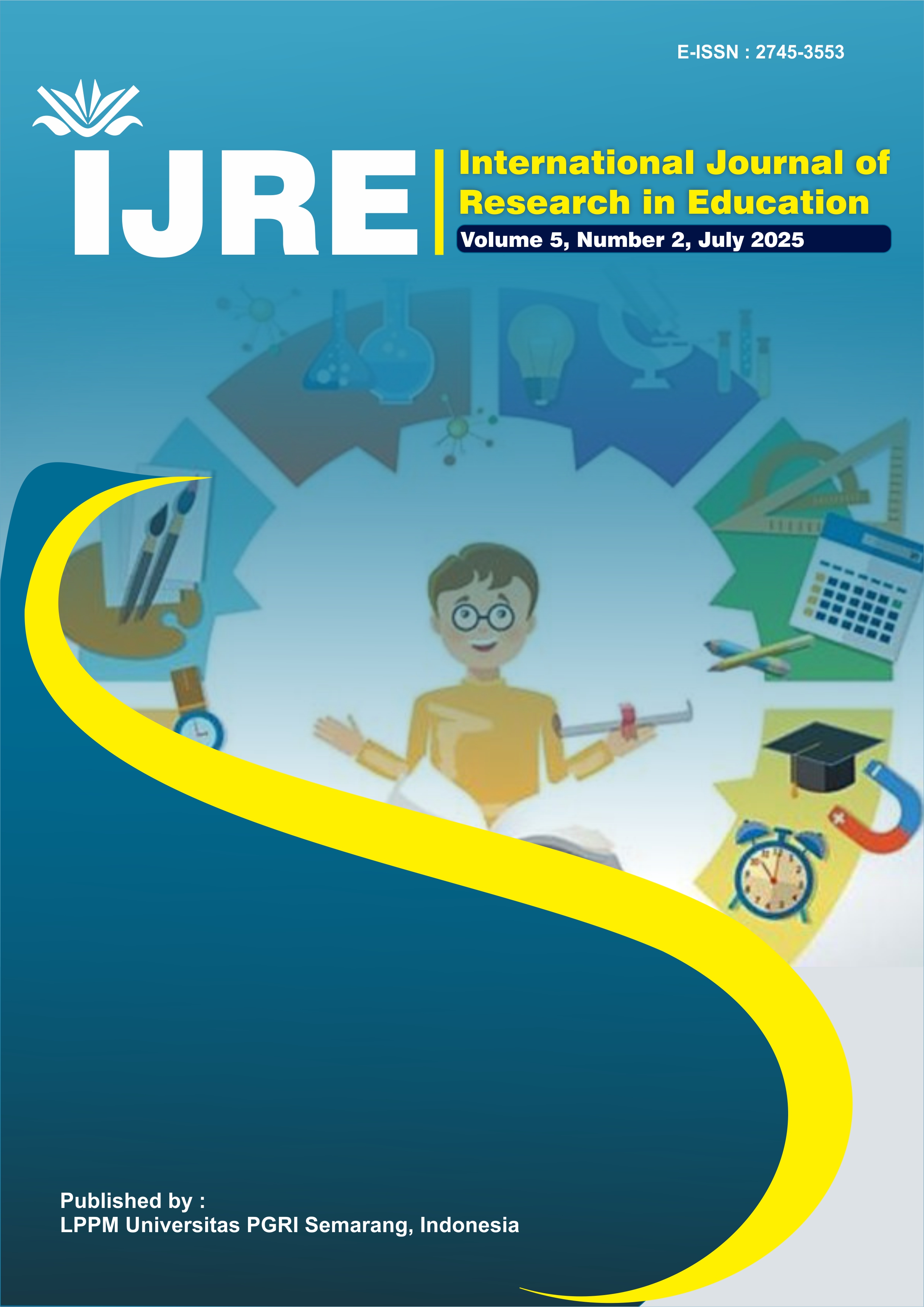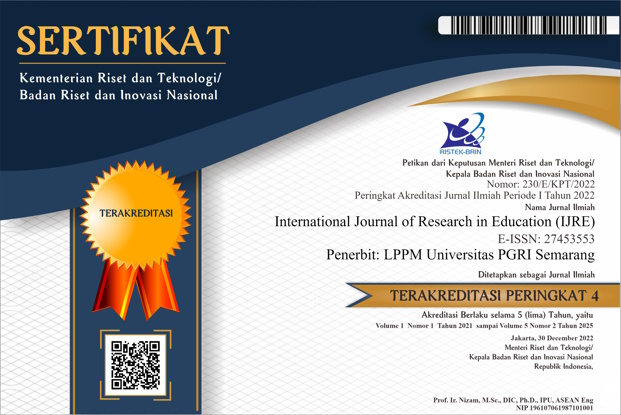Exploring Public Speaking Anxiety: Does Gender Really Matter?
DOI:
https://doi.org/10.26877/pwtwrp44Keywords:
gender , speaking anxiety, public speaking anxiety , high school studentsAbstract
This study aims to identify differences in public speaking anxiety levels between male and female students. A quantitative approach with a comparative design was used. The participants consisted of all 194 twelfth-grade students at SMAN 61 Jakarta, including 83 male and 111 female students. Data were collected through a questionnaire adapted from the Personal Report of Public Speaking Anxiety, which was translated and revalidated to suit the participant context. After a validity test, 27 items were included in the analysis. Anxiety scores were calculated using a three-step formula and categorized into low, moderate, and high levels. Data analysis was conducted using descriptive statistics and an independent samples t-test with SPSS version 29. The results showed no significant difference in public speaking anxiety between male and female students. However, descriptive findings indicated that female students generally showed slightly higher anxiety levels. This suggests that anxiety is influenced more by personal factors than gender. Educators are encouraged to provide equal speaking opportunities and build supportive classroom environments for all students.
References
Angellia, & Listyani. (2019). Freshmens anxiety in an intensive listening class: A qualitative study. Educational Research and Reviews, 14(12), 443–457. https://doi.org/10.5897/err2018.3624
Broeckelman-Post, M. A., Hawkins, K. E. H., Murphy, J., Otusanya, A., & Kueppers, G. (2020). The impact of gender and introductory communication course type on public speaking performance. Communication Teacher, 34(1), 53–67. https://doi.org/10.1080/17404622.2019.1593478
Brown, H. D. (2007). PRINCIPLES of LANGUAGE LEARNING AND TEACHING (fifth edit). https://doi.org/10.1017/cbo9781139062398.015
Daflizar, D. (2024). Out-of-Class Speaking Anxiety among Indonesian EFL Students and Its Relationship with Self-Perceived Speaking Skills, Vocabulary Proficiency, and Gender. Journal of Languages and Language Teaching, 12(1), 240. https://doi.org/10.33394/jollt.v12i1.9342
Dimas, D. R., & Dzul, D. R. (2024). The Variation on Speaking Anxiety in Presentation Based on Genders. Journal of English Language Learning, 8(1), 578–589. https://doi.org/10.31949/jell.v8i1.10278
Farhane-Medina, N. Z., Luque, B., Tabernero, C., & Castillo-Mayén, R. (2022). Factors associated with gender and sex differences in anxiety prevalence and comorbidity: A systematic review. Science Progress, 105(4), 1–30. https://doi.org/10.1177/00368504221135469
Fathikasari, N., Gozali, A., & Ratri, D. P. (2022). PUBLIC SPEAKING ANXIETY OF UNIVERSITY STUDENTS IN EFL CONTEXT. 7(1), 40–44.
Fauziah, A., Wati, S., & Solihati, T. A. (2022). Gender Differences in Speaking Anxiety. Etnolingual, 6(1), 1–13. https://doi.org/10.20473/etno.v6i1.34064
Gallego, A., McHugh, L., Penttonen, M., & Lappalainen, R. (2022). Measuring Public Speaking Anxiety: Self-report, behavioral, and physiological. Behavior Modification, 46(4), 782–798. https://doi.org/10.1177/0145445521994308
Gregersen, T., & Horwitz, E. K. (2002). Language Learning and Perfectionism: Anxious and Non‐Anxious Language Learners’ Reactions to Their Own Oral Performance. The Modern Language Journal, 86(4), 562–570. https://doi.org/10.1111/1540-4781.00161
Hamandia, M. R. (2022). Analisis Konseptual Mengenai Kecemasan Dalam Berbicara Di Depan Umum. In Jurnal Komunikasi Islam dan Kehumasan (JKPI) (Vol. 6, Issue 1, pp. 59–70). https://doi.org/10.19109/jkpi.v6i1.12956
Horwitz, E. K., Horwitz, M. B., & Cope, J. (1986). Foreign Language Classroom Anxiety. The Modern Language Journal, 70(2), 125–132. https://doi.org/10.1111/j.1540-4781.1986.tb05256.x
Kadwa, M. S., & Alshenqeeti, H. (2020). International Journal of Linguistics, Literature and Translation (IJLLT) The Impact of Students’ Proficiency in English on Science Courses in a Foundation Year Program. International Journal of Linguistics, Literature and Translation (IJLLT), 3(11), 55–67. https://doi.org/10.32996/ijllt
Kalra, R., & Siribud, S. (2020). Public speaking anxiety in the Thai EFL context. LEARN Journal: Language Education and Acquisition Research Network, 13(1), 195–209.
Ladarević, M. N. (2021). Examining the key factors behind foreign language anxiety (FLA) in online teaching of English for Specific Purposes (ESP). ExELL, 9(2), 106–142. https://doi.org/https://doi.org/10.2478/exell-2022-0005
Lamba, A., Frank, M. J., & FeldmanHall, O. (2020). Anxiety Impedes Adaptive Social Learning Under Uncertainty. Psychological Science, 31(5), 592–603. https://doi.org/10.1177/0956797620910993
Lestari, D. A., Ma’mun, A. H., & Ahmad, Z. (2024). the Investigation of Anxiety on English Language Learning in High School Students: a Case Study in Grade Elevent. Klasikal : Journal of Education, Language Teaching and Science, 6(2), 358–369. https://doi.org/10.52208/klasikal.v6i2.1161
Li, T. (2020). Analysis on the Causes and Treatment of Public Speaking Anxiety. 466(Isemss), 514–518. https://doi.org/10.2991/assehr.k.200826.103
Lintner, T., & Belovecová, B. (2024). Demographic predictors of public speaking anxiety among university students. Current Psychology, 43(30), 25215–25223. https://doi.org/10.1007/s12144-024-06216-w
Mccroskey, J. C. (1970). Measures of communication‐bound anxiety. 37(November 2012), 269–277. https://doi.org/https://doi.org/10.1080/03637757009375677
Megawati, M., & Apriani, T. (2023). The Dynamics of Public Speaking Anxiety and its Impact on Speaking Performance: A Study Among College Students in Business and Economics. Jurnal Ilmiah Manajemen Kesatuan, 11(3), 627–636. https://doi.org/10.37641/jimkes.v11i3.2156
Noor, A. M., Rafek, M., Zarina, P., Khalid, M., & Mohammad, R. (2015). Communication Apprehension in Language Learning: Is It Serious? International Journal of Arts & Sciences, 8(2), 311–320.
Pristiyaputri, A.E., Afiqoh, M., Jauhari, M.A., Al Afghani, M.J., & K. (2023). THE DIFFERENCES OF SPEAKING ANXIETY ACROSS ACADEMIC LEVELS AND GENDER. The Journal of English Literacy Education, 10(1), 63–80. https://doi.org/https://doi.org/10.36706/jele.v10i1.20292
Rahman Hz, B. I. (2022). Exploring Gender Differences in Public Speaking Anxiety. Sawwa: Jurnal Studi Gender, 17(2), 247–266. https://doi.org/10.21580/sa.v17i2.14295
Rajitha, K., & Alamelu, C. (2020). A study of factors affecting and causing speaking anxiety. Procedia Computer Science, 172(2019), 1053–1058. https://doi.org/10.1016/j.procs.2020.05.154
Sokoy, M. (2023). Factors Influencing Speaking Anxiety At One Public University in Jambi: Language and Academic Aspects. JELT (Jambi-English Language Teaching), 7(1), 1–12. https://doi.org/10.22437/jelt.v7i1.13796
Sulastiani. (2020). Students’ Perception toward Psychological Problems Faced in Public Speaking Class. Journal La Edusci, 1(1), 33–39. https://doi.org/10.37899/journallaedusci.v1i1.46
Tarbani, H. N., Utami, P. P., & Santika, T. (2024). PUBLIC SPEAKING ANXIETY DURING ORAL PRESENTATION : FACTORS AFFECTING AND HOW STUDENTS OVERCOME IT. 12(November), 223–236. https://doi.org/10.35706/judika.v12i2.11850
Tee, X. T., Kamarulzaman, W., & Tan Joanna, T. A. (2020). A Systematic Review of Self-Coping Strategies Used by University Students to Cope with Public Speaking Anxiety. English Language Teaching, 13(10), 57. https://doi.org/10.5539/elt.v13n10p57
Trisnaningati, Z. R., & Sinambela, F. C. (2021). Self-efficacy, Emotional Regulation, Communication Competence and Public Speaking Anxiety Towards Students. Proceedings of the International Conference on Psychological Studies (ICPSYCHE 2020), 530(Icpsyche 2020), 68–74. https://doi.org/10.2991/assehr.k.210423.010



